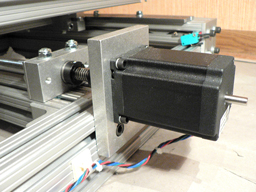 It is very important to set goals before attempting to design and build anything, especially precise CNC machine. While working on the machine I had several things in mind:
It is very important to set goals before attempting to design and build anything, especially precise CNC machine. While working on the machine I had several things in mind:
- CNC machine should not have any hard-to-get or hard-to-work-with components. All key components are made of aluminum extrusion: it is rigid enough for our purposes - we are not going to machine steel at high speeds (and hardly at low speeds either) - very convenient and easy to work with.
- CNC machine must be capable of machining wood (all sorts), plastics and soft metals (aluminum, brass etc). I decided to incorporate moving table design, because it makes the machine more rigid and less prone to vibrations.
- Since we are going to machine soft metals, we need a good resolution. While researching I found out that it is better to rely on whole step resolution then on microstepping, because microstepping is less repeatable and less precise. My goal was to achieve precision of not less then 0.001" (0.0254 mm) per whole step. That is why I have chosen to use single-start ACME screws. They gave me a resolution of 0.0005" (0.0127 mm) per step and 0.00005" (0.00127 mm) per 1/10th step (1 microstep). However, DIY CNC machine accuracy is almost always lower then its resolution. This is because of cutting forces and loads involved. Accuracy of this particular CNC machine will be close to 0.01", this is good enough for DIY CNC machine.
- I have designed my machine for work on 19" aluminum front panels. This means that its working area should be at least 19" x 8". In its current revision, my CNC machine has working area of 23" x 12.8". This is sufficient for milling a contour of the panel without having to reposition the piece on the table.
- Moving table machines have larger effective footprint than moving gantry ones. This is the price one has to pay for a fixed (and thus more rigid) gantry. Moving gantry style machines do not need additional space to function, but moving table machines do need some because their table moves in and out (or to the left and to the right). It is much easier to design a large machine with moving gantry than with moving table. That is why most big routers are moving gantry style machines. For metal work however, machine must be very rigid. And this is where you want in to be a moving table machine. The footprint of my machine base is 30" x 24" (approximately 37" x 31" with stepper motors). Clearance should be provided at the front and at the back of the machine (approximately 3.5" at each side, which yields to 37" x 38" effective footprint with steppers). My machine is not as big as some routers with 2' x 3' working area, but it offers much more rigidity and has large enough working area for common tasks. Please note that you will need to consider some space for a computer as well.
- The backlash of the machine should be as small as possible. It is difficult to predict the actual amount of backlash, but when I finished the build I was able to achieve the backlash of 0.0001" or less on all axes.